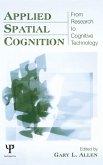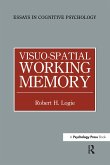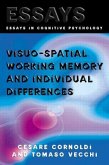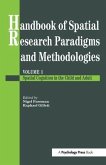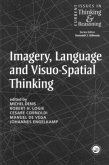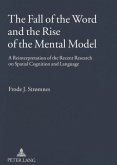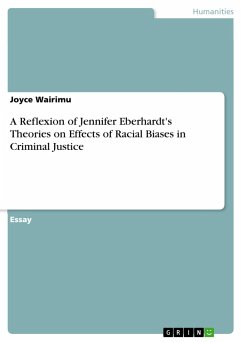Spatial Biases in Perception and Cognition
Herausgeber: Hubbard, Timothy L
Spatial Biases in Perception and Cognition
Herausgeber: Hubbard, Timothy L
- Gebundenes Buch
- Merkliste
- Auf die Merkliste
- Bewerten Bewerten
- Teilen
- Produkt teilen
- Produkterinnerung
- Produkterinnerung
Numerous spatial biases influence navigation, interactions, and preferences in our environment. This volume considers their influences on perception and memory.
Andere Kunden interessierten sich auch für
![Applied Spatial Cognition Applied Spatial Cognition]() Applied Spatial Cognition188,99 €
Applied Spatial Cognition188,99 €![Visuo-spatial Working Memory Visuo-spatial Working Memory]() Robert H LogieVisuo-spatial Working Memory180,99 €
Robert H LogieVisuo-spatial Working Memory180,99 €![Visuo-Spatial Working Memory and Individual Differences Visuo-Spatial Working Memory and Individual Differences]() Cesare CornoldiVisuo-Spatial Working Memory and Individual Differences189,99 €
Cesare CornoldiVisuo-Spatial Working Memory and Individual Differences189,99 €![Handbook of Spatial Research Paradigms and Methodologies Handbook of Spatial Research Paradigms and Methodologies]() Nigel Foreman / Raphael Gillett (eds.)Handbook of Spatial Research Paradigms and Methodologies180,99 €
Nigel Foreman / Raphael Gillett (eds.)Handbook of Spatial Research Paradigms and Methodologies180,99 €![Imagery, Language and Visuo-Spatial Thinking Imagery, Language and Visuo-Spatial Thinking]() Johannes EngelKamp / Robert Logie / Manuel Vega (eds.)Imagery, Language and Visuo-Spatial Thinking180,99 €
Johannes EngelKamp / Robert Logie / Manuel Vega (eds.)Imagery, Language and Visuo-Spatial Thinking180,99 €![The Fall of the Word and the Rise of the Mental Model The Fall of the Word and the Rise of the Mental Model]() Frode J. StromnesThe Fall of the Word and the Rise of the Mental Model140,85 €
Frode J. StromnesThe Fall of the Word and the Rise of the Mental Model140,85 €![A Reflexion of Jennifer Eberhardt's Theories on Effects of Racial Biases in Criminal Justice A Reflexion of Jennifer Eberhardt's Theories on Effects of Racial Biases in Criminal Justice]() Joyce WairimuA Reflexion of Jennifer Eberhardt's Theories on Effects of Racial Biases in Criminal Justice15,95 €
Joyce WairimuA Reflexion of Jennifer Eberhardt's Theories on Effects of Racial Biases in Criminal Justice15,95 €-
-
-
Numerous spatial biases influence navigation, interactions, and preferences in our environment. This volume considers their influences on perception and memory.
Hinweis: Dieser Artikel kann nur an eine deutsche Lieferadresse ausgeliefert werden.
Hinweis: Dieser Artikel kann nur an eine deutsche Lieferadresse ausgeliefert werden.
Produktdetails
- Produktdetails
- Verlag: Cambridge University Press
- Seitenzahl: 494
- Erscheinungstermin: 11. Oktober 2018
- Englisch
- Abmessung: 241mm x 170mm x 30mm
- Gewicht: 885g
- ISBN-13: 9781107154988
- ISBN-10: 1107154987
- Artikelnr.: 50507846
- Herstellerkennzeichnung
- Libri GmbH
- Europaallee 1
- 36244 Bad Hersfeld
- gpsr@libri.de
- Verlag: Cambridge University Press
- Seitenzahl: 494
- Erscheinungstermin: 11. Oktober 2018
- Englisch
- Abmessung: 241mm x 170mm x 30mm
- Gewicht: 885g
- ISBN-13: 9781107154988
- ISBN-10: 1107154987
- Artikelnr.: 50507846
- Herstellerkennzeichnung
- Libri GmbH
- Europaallee 1
- 36244 Bad Hersfeld
- gpsr@libri.de
Part I. Anisotropies and Illusions: 1. Perceptual biases in elementary
geometry Michael Morgan; 2. Perceptual anisotropies in visual space J.
Antonio Aznar-Casanova; 3. Situated influences on spatial-numerical
associations Krzysztof Cipora, Katarzyna Patro and Hans-Christoph Nürk; 4.
S-R compatibility with physical and representational locations: the Simon,
SMARC, and STEARC effects Carlo Umiltà, Mario Bonato and Elena Rusconi; 5.
Unraveling the paradox of spatial pitch Ophelia Deroy, Irune
Fernandez-Preito, Jordi Navarra and Charles Spence; 6. Representational
biases in space and language Alexander Kranjec; Part II. Dynamics of
Objects: 7. Mislocalizations at the onset position of moving stimuli Jochen
Müsseler and Dirk Kerzel; 8. Influences on representational momentum
Timothy L. Hubbard; 9. The flash-lag effect Timothy L. Hubbard; 10.
Perceptual and motor biases in reference to gravity Myrka Zago; 11.
Auditory biases in visual motion perception Wataru Teramoto, Souta Hidaka
and Yoichi Sugita; 12. Adaptive biases in visual and auditory looming
perception John G. Neuhoff; Part III. Dynamics in Scenes: 13. Expanding
space: does imagination affect boundary extension for visual scenes? Helene
Intraub; 14. Spatial contraries and mirrors Ivana Bianchi and Ugo Savardi;
15. Aesthetics and preferences in scene and spatial composition Timothy L.
Hubbard; 16. Spatial biases in thought and judgment: reference theory
Barbara Tversky; 17. Categorical influences on spatial bias Nora Newcombe;
Part IV. Perception and Action: 18. Spatial bias after brain damage: the
case of visual neglect Pom Charras, Juan Lupianez and Paolo Bartolomeo; 19.
Natural regularities and coupled predictive perceptual and cognitive
biases: why we evolved to systematically experience spatial illusions
Michael McBeath; 20. Two 'inhibitions of return' bias orienting differently
Raymond M. Klein and Ralph S. Redden; 21. Spatial biases from action
Jessica K. Witt; 22. Spatial biases in navigation and wayfinding Jan M.
Wiener and Tobias Meilinger; 23. Grounding social cognition in space
Caterina Suitner and Thomas W. Schubert; 24. Forms of bias in cognitive
science: moving beyond perception, action, and cognition J. Scott Jordan,
Vincent Cialdella, Dan S. Schloesser and Jiuyang Bai.
geometry Michael Morgan; 2. Perceptual anisotropies in visual space J.
Antonio Aznar-Casanova; 3. Situated influences on spatial-numerical
associations Krzysztof Cipora, Katarzyna Patro and Hans-Christoph Nürk; 4.
S-R compatibility with physical and representational locations: the Simon,
SMARC, and STEARC effects Carlo Umiltà, Mario Bonato and Elena Rusconi; 5.
Unraveling the paradox of spatial pitch Ophelia Deroy, Irune
Fernandez-Preito, Jordi Navarra and Charles Spence; 6. Representational
biases in space and language Alexander Kranjec; Part II. Dynamics of
Objects: 7. Mislocalizations at the onset position of moving stimuli Jochen
Müsseler and Dirk Kerzel; 8. Influences on representational momentum
Timothy L. Hubbard; 9. The flash-lag effect Timothy L. Hubbard; 10.
Perceptual and motor biases in reference to gravity Myrka Zago; 11.
Auditory biases in visual motion perception Wataru Teramoto, Souta Hidaka
and Yoichi Sugita; 12. Adaptive biases in visual and auditory looming
perception John G. Neuhoff; Part III. Dynamics in Scenes: 13. Expanding
space: does imagination affect boundary extension for visual scenes? Helene
Intraub; 14. Spatial contraries and mirrors Ivana Bianchi and Ugo Savardi;
15. Aesthetics and preferences in scene and spatial composition Timothy L.
Hubbard; 16. Spatial biases in thought and judgment: reference theory
Barbara Tversky; 17. Categorical influences on spatial bias Nora Newcombe;
Part IV. Perception and Action: 18. Spatial bias after brain damage: the
case of visual neglect Pom Charras, Juan Lupianez and Paolo Bartolomeo; 19.
Natural regularities and coupled predictive perceptual and cognitive
biases: why we evolved to systematically experience spatial illusions
Michael McBeath; 20. Two 'inhibitions of return' bias orienting differently
Raymond M. Klein and Ralph S. Redden; 21. Spatial biases from action
Jessica K. Witt; 22. Spatial biases in navigation and wayfinding Jan M.
Wiener and Tobias Meilinger; 23. Grounding social cognition in space
Caterina Suitner and Thomas W. Schubert; 24. Forms of bias in cognitive
science: moving beyond perception, action, and cognition J. Scott Jordan,
Vincent Cialdella, Dan S. Schloesser and Jiuyang Bai.
Part I. Anisotropies and Illusions: 1. Perceptual biases in elementary
geometry Michael Morgan; 2. Perceptual anisotropies in visual space J.
Antonio Aznar-Casanova; 3. Situated influences on spatial-numerical
associations Krzysztof Cipora, Katarzyna Patro and Hans-Christoph Nürk; 4.
S-R compatibility with physical and representational locations: the Simon,
SMARC, and STEARC effects Carlo Umiltà, Mario Bonato and Elena Rusconi; 5.
Unraveling the paradox of spatial pitch Ophelia Deroy, Irune
Fernandez-Preito, Jordi Navarra and Charles Spence; 6. Representational
biases in space and language Alexander Kranjec; Part II. Dynamics of
Objects: 7. Mislocalizations at the onset position of moving stimuli Jochen
Müsseler and Dirk Kerzel; 8. Influences on representational momentum
Timothy L. Hubbard; 9. The flash-lag effect Timothy L. Hubbard; 10.
Perceptual and motor biases in reference to gravity Myrka Zago; 11.
Auditory biases in visual motion perception Wataru Teramoto, Souta Hidaka
and Yoichi Sugita; 12. Adaptive biases in visual and auditory looming
perception John G. Neuhoff; Part III. Dynamics in Scenes: 13. Expanding
space: does imagination affect boundary extension for visual scenes? Helene
Intraub; 14. Spatial contraries and mirrors Ivana Bianchi and Ugo Savardi;
15. Aesthetics and preferences in scene and spatial composition Timothy L.
Hubbard; 16. Spatial biases in thought and judgment: reference theory
Barbara Tversky; 17. Categorical influences on spatial bias Nora Newcombe;
Part IV. Perception and Action: 18. Spatial bias after brain damage: the
case of visual neglect Pom Charras, Juan Lupianez and Paolo Bartolomeo; 19.
Natural regularities and coupled predictive perceptual and cognitive
biases: why we evolved to systematically experience spatial illusions
Michael McBeath; 20. Two 'inhibitions of return' bias orienting differently
Raymond M. Klein and Ralph S. Redden; 21. Spatial biases from action
Jessica K. Witt; 22. Spatial biases in navigation and wayfinding Jan M.
Wiener and Tobias Meilinger; 23. Grounding social cognition in space
Caterina Suitner and Thomas W. Schubert; 24. Forms of bias in cognitive
science: moving beyond perception, action, and cognition J. Scott Jordan,
Vincent Cialdella, Dan S. Schloesser and Jiuyang Bai.
geometry Michael Morgan; 2. Perceptual anisotropies in visual space J.
Antonio Aznar-Casanova; 3. Situated influences on spatial-numerical
associations Krzysztof Cipora, Katarzyna Patro and Hans-Christoph Nürk; 4.
S-R compatibility with physical and representational locations: the Simon,
SMARC, and STEARC effects Carlo Umiltà, Mario Bonato and Elena Rusconi; 5.
Unraveling the paradox of spatial pitch Ophelia Deroy, Irune
Fernandez-Preito, Jordi Navarra and Charles Spence; 6. Representational
biases in space and language Alexander Kranjec; Part II. Dynamics of
Objects: 7. Mislocalizations at the onset position of moving stimuli Jochen
Müsseler and Dirk Kerzel; 8. Influences on representational momentum
Timothy L. Hubbard; 9. The flash-lag effect Timothy L. Hubbard; 10.
Perceptual and motor biases in reference to gravity Myrka Zago; 11.
Auditory biases in visual motion perception Wataru Teramoto, Souta Hidaka
and Yoichi Sugita; 12. Adaptive biases in visual and auditory looming
perception John G. Neuhoff; Part III. Dynamics in Scenes: 13. Expanding
space: does imagination affect boundary extension for visual scenes? Helene
Intraub; 14. Spatial contraries and mirrors Ivana Bianchi and Ugo Savardi;
15. Aesthetics and preferences in scene and spatial composition Timothy L.
Hubbard; 16. Spatial biases in thought and judgment: reference theory
Barbara Tversky; 17. Categorical influences on spatial bias Nora Newcombe;
Part IV. Perception and Action: 18. Spatial bias after brain damage: the
case of visual neglect Pom Charras, Juan Lupianez and Paolo Bartolomeo; 19.
Natural regularities and coupled predictive perceptual and cognitive
biases: why we evolved to systematically experience spatial illusions
Michael McBeath; 20. Two 'inhibitions of return' bias orienting differently
Raymond M. Klein and Ralph S. Redden; 21. Spatial biases from action
Jessica K. Witt; 22. Spatial biases in navigation and wayfinding Jan M.
Wiener and Tobias Meilinger; 23. Grounding social cognition in space
Caterina Suitner and Thomas W. Schubert; 24. Forms of bias in cognitive
science: moving beyond perception, action, and cognition J. Scott Jordan,
Vincent Cialdella, Dan S. Schloesser and Jiuyang Bai.


